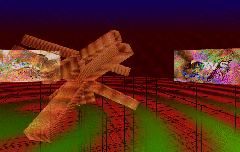Push / Pop
May 5th, 1994 - January 15th, 1996
Categories: MFA Thesis, VR Art

About
Computer graphics is on a quest, an obsessive mission, to perfectly replicate reality. This Michelangelo envy has resulted in the focus and advancement of computer graphics technology on rendering complex images and animations. Real time computer graphics also yearns for this duplication of the world we experience, but at a much different pace. Whereas, rendered images can take up to hours to complete, the real time computer graphics image must be rendered at least thirty times per second. Virtual reality environments depend upon this real time computer generated imagery to create a sense of immersion and interaction. Because of current computing technology it is extremely difficult to depict a natural realism in virtual reality. Nevertheless, that goal is the obsession.
Push / Pop depicts a crude but effective rendering of the Gallery400 in Chicago. The application starts with the user facing a simulation of the Immersadesk. Using a joystick mounted on a wand, a user is allowed to navigate through the gallery. Five columns of the gallery are used as portals for entering into abstract spaces. The term Push / Pop (though technically is derived from pushmatrix and popmatrix GL function calls in coding language) refers to the action of pushing from depicted reality into an abstract environment. After experiencing these abstract spaces a user can then “Pop” back into the real gallery space.
In the virtual Gallery400 there are two sculptures on pedestals. These two pieces represent a couple things. The sculptures presence directly illustrates the power and illusion capable with three dimensional stereo graphics. When the user gets close to one of the objects they can then extend a hand towards the illusion and conceptually touch the object. This illusion is the most powerful quality of virtual reality environments. A little closer though and the user is pushed into an alternative gallery space. This dynamic change of environment creates a desire to return to the sculpted objects in the realistic Gallery400. You can get close but not too close.
The objects also represent the potential design tool which a virtual reality environment can become. These objects were designed by writing a computer program which allows for the designer to manipulate, rotate and repeat various sized rectangular objects until the desired shape and form is conceived. The resultant matrix of vertices’ points can then be translated into other software packages in which they in turn can be translated into file formats readable by commercial manufactures. The virtual environment allows a designer to examine in great detail a sculpture previous to any physical modeling.
Push / Pop is an MFA Thesis project by Tom Coffin. It was also shown at The Bridge Art Show at SIGGRAPH 96.